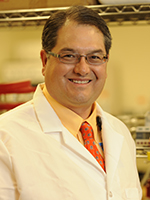
Professor
Unit: Drug Discovery and Development
Auburn University
Harrison College of Pharmacy
3211g Walker Building
Auburn, AL 36849
Email: driese@auburn.edu
Phone: 334-844-8358
Fax: 334-844-8353
1993-95: Postdoctoral Fellow, Department of Pathology - Yale University
1995-97: Associate Research Scientist, Department of Pathology, Yale University
1997-2010: Assistant/Associate Professor, Department of Medicinal Chemistry and Molecular Pharmacology, Purdue University
1997-2010: Assistant/Associate Professor, Purdue University Center for Cancer Research
2010-18: Adjunct Professor, Department of Medicinal Chemistry and Molecular Pharmacology, Purdue University
2010-18: Associate Dean for Research and Graduate Programs, Auburn University Harrison College of Pharmacy
2010-21: Gilliland Endowed Professor, Department of Drug Discovery and Development, Auburn University Harrison College of Pharmacy
2020-present: Senior Scientist, Cancer Biology and Immunology Program, O’Neal Comprehensive Cancer Center, University of Alabama-Birmingham
2021-present: Professor, Department of Drug Discovery and Development, Auburn University Harrison College of Pharmacy
Targeted Melanoma Therapy: Identification of ERBB4 Melanoma Driver Mutants
Auburn University Intramural Grants Program
2020-2022
Role: Principal Investigator
Total Cost: $50,000
Graduate Students
Overview – We study the Epidermal Growth Factor (EGF) family of peptide hormones and their receptors, the ErbB receptor tyrosine kinases. This network regulates the proliferation and differentiation of epithelial cells and deregulated signaling by this network contributes to human tumorigenesis and increased tumor cell invasiveness, metastatic potential, and chemoresistance. Consequently, we seek to understand the mechanism by which this network regulates cell function, with the ultimate goal being the development of novel cancer treatments.
ERBB4 Signaling and ERBB4 Inhibitors – We have demonstrated that ERBB4 homodimers function as tumor suppressor proteins, whereas ERBB4-EGFR and ERBB4-ERBB2 heterodimers function as oncogenes. We are focused on deciphering the mechanisms by which ERBB4 can be coupled to these divergent responses [19, 25, 26, 41, 44, 50, 57]. We are also pursuing the discovery and development of novel ERBB4 agonists and antagonists that can be used to pharmacologically probe ERBB4 function in human malignancies and hold potential for the treatment of ErbB4-dependent tumors [30, 36, 42, 46, 55].
ERBB4 in Human Tumors – We have reviewed the roles that ERBB4 and its ligands play in human tumors [51, 57]. These reviews summarize the rationale for several projects underway in our laboratory. Metastatic melanomas that possess wild type (WT) BRAF alleles are particularly deadly, as they do not respond to BRAF inhibitors, MEK inhibitors, or other targeted chemotherapeutics. Our preliminary data indicate that ERBB4 heterodimers function as oncogenes in human melanoma cell lines that possess BRAF WT alleles. We are developing in silico methods to assess whether ERBB4 mutations found in BRAF WT melanoma samples function are likely to function as melanoma drivers [56]. We are utilizing in vitro and in vivo model systems to define the roles of ERBB4 overexpression, ERBB4 heterodimerization partners, ERBB4 ligands, and ERBB4 mutations in BRAF WT human melanoma. Similar but less advanced efforts are underway to determine the role of ERBB4 signaling in human childhood brain tumors and triple negative cancers.
#Contributes to my Google Scholar i10-Index of 49
*Contributes to my Google Scholar H-index of 35